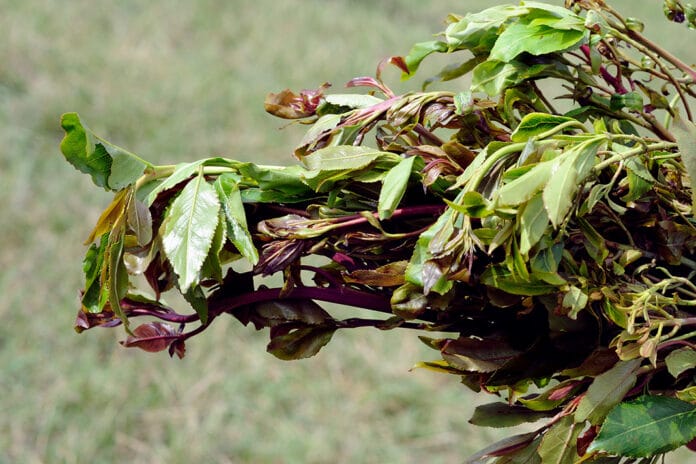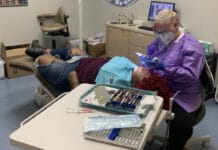Decades ago, I watched a documentary on Yemen that showed how in Yemeni culture, people habitually chewed some sort of leaves, especially during social gatherings. Since I did not know many cultures had the habit of chewing leaves, this memory stayed with me.
Fast forward to dental hygiene school, and during my third semester, I treated a patient who was born and raised in Yemen. When taking his medical history, I recalled that documentary and casually asked him if he had ever chewed those leaves. He answered that he was very much familiar with it and elaborated further that these leaves were called “khat” or “qat.” They were chewed at social events and had a slight stimulant effect.
I noted this discovery in the “Habits” section of his health history. During the extraoral/intraoral exam, I found a quarter-sized white lesion inside his left cheek. It was a classic leukoedema. I asked my patient if he had ever noticed this change in the color on his buccal area? He said no, but he told me that this is the area where he retained the chewed khat leaves for a long duration to get the stimulant effect.
After showing the lesion to my instructor, I took a picture of the lesion with an intraoral camera and documented it in my EIOE tab.
Oral and Systemic Effects of the Khat Leaves
Khat (Catha edulis) is a plant found in southern Arabia and East Africa. Its leaves and small twigs are chewed and then retained inside the cheek by millions of people of that region for its amphetamine-like effect.1 Studies suggest that khat leaf chewing is associated with oral conditions such as keratotic white lesions, mucosal pigmentation, periodontal diseases, tooth loss, plasma cell stomatitis, and xerostomia. There is also a weak connection between these lesions becoming malignant.1
Khat leaves can also be dried up and can be used to make tea, which has a euphoric effect when consumed. Aside from its dental risks, khat may have systemic effects on the digestive system, cardiovascular system, and neurophysiological systems.4
During the cultivation of khat plants, pesticides are used that adds to the systemic risks on a chronic khat user, especially having complications in the cardiovascular system, neurological damage, and reduction of antioxidant defense mechanism.2
The Legal Status of Khat in the U.S.
Although acceptable for use in countries located in the Horn of Africa and the Arab peninsula, its import and consumption in the United States are illegal. The reason for its illicit nature, according to National Drug Intelligence Center, is that khat contains a substance called cathinone-a, which is a highly addictive Schedule I drug under the Controlled Substances Act.3
Dental Patients Who Use Khat
Our instructors always told us to examine a patient as a detective. Search for clues and try to put the pieces together for the final diagnosis. It was by pure luck that I had seen the documentary about Yemen and the use of khat. If I didn’t know what khat was, I would have never linked the leukoedema with khat consumption, and my patient might have ignored telling me about his khat habit.
They say a picture speaks a thousand words. The intraoral picture of leukoedema really shocked the patient. He had not realized what khat was doing to his oral cavity. I also explained to him that khat was an irritant, which is why it was changing the color of his mucosa.
The United States welcomes many immigrants each year, and dental hygienists might encounter patients from East Africa or the Arabian Peninsula. Americans are generally unfamiliar with khat leaves, but dental professionals might end up with patients with a background in a country where khat is consumed. If that happens, we should always be mindful of its effects on the oral cavity. We should inform and educate the patient about its potential health risks.
These risks range from a simple change in color to pre-carcinogenic lesions. Intraoral pictures can be really helpful with this explanation. These patients should also take extra care of their mouths with frequent rinsing, interdental cleaning, and brushing. Being vigilant about good oral hygiene hopefully would reduce the harmful chemicals that are produced by these leaves.
Sadly, there hasn’t been any long-term, at-home care procedure documented for khat users, but the above-mentioned steps will surely help. Having more frequent dental visits may also be needed to keep things in check. Documentation of all the aspects of khat use, its frequency, duration, oral effects should be prioritized for the follow-up. Patients should also be educated about the legal aspect of khat as it is illegal in the U.S.
As the population of the U.S is becoming more diverse, the role of dental hygienists is expanding. Our knowledge needs to expand beyond just tobacco cessation. We need to become familiar with substances consumed by different cultures, what their impacts are, and what is the legal status of these habits here in the U.S. There is also a great potential for research and education in knowing these demographical habits. Like tobacco, maybe at some point, these substances need to be added to AAP Staging and Grading of Periodontal Diseases.
Need CE? Check Out the Self-Study CE Courses from Today’s RDH!
Listen to the Today’s RDH Dental Hygiene Podcast Below:
References
- Al-Maweri, S.A., Warnakulasuriya, S., Samran, A. Khat (Catha edulis) and its oral health effects: An updated review. Journal of Investigative and Clinical Dentistry. 2018; 9(1). Retrieved from https://doi-org.library.collin.edu/10.1111/jicd.12288
- Atnafie, S.A., Muluneh, N.Y., Getahun, K.A., Tsegaw Woredekal, A., Kahaliw, W. Pesticide residue analysis of khat leaves and health risks among khat chewers in the Amhara Region, Northwestern Ethiopia. Journal of Environmental and Public Health. 2021; 4680573. Retrieved from https://doi-org.library.collin.edu/10.1155/2021/4680573
- Khat Fast Facts. (n.d.). National Drug Intelligence Center. Retrieved from https://www.justice.gov/archive/ndic/pubs31/31482/index.htm
- Malasevskaia, I., Al-Awadhi, A.A., Mohammed, L. Tea in the morning and khat afternoon: Health threats due to khat chewing. Cureus. 2020; 12(12): e12363. Retrieved from https://doi-org.library.collin.edu/10.7759/cureus.12363











